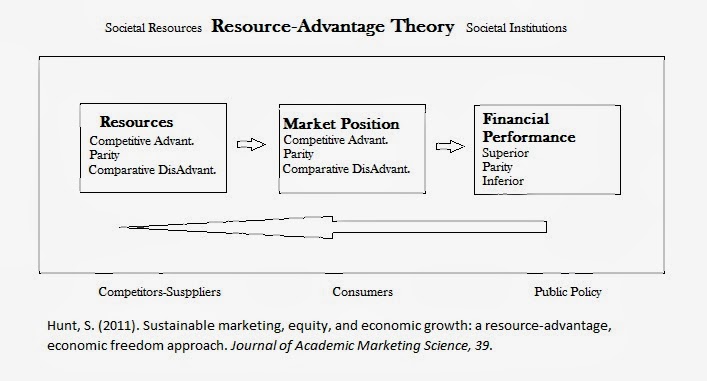Sustainable marketing is an activity that supports sustainable
economic growth. That leaves open the question of what sustainable growth is.
To some it may focus on wealth generation while to others it is societal
development. Of course, this doesn’t do much if that wealth only makes its way
into a few hands. Sustainable marketing and sustainable growth must therefore
include concepts of greater system development that makes its way throughout the
societal networks to raise the status of all members. A paper by Shelby Hunt
helps describe two theories of economics that focus on creating sustainable
systems.
Sustainable economic growth can be seen as improvements
in the ecological (environment), social (equity), and financial (economic)
arenas (Savitz & Weber, 2006). A collapse or deficiency in anyone of these
areas can impact the trajectory of growth. For example, an ecological collapse
based upon pollution could lower life expectancy, human growth, and raise
costs. Likewise, social in-equity is unstable and can cause riots, fighting,
and crime. The decline of the economic engine can cause damage in other areas
leading to collapse.
Two economic models help put together a framework
for growth. These include the necoclassical static-equilibrium growth theory
(Solow, 1966) and resource-advantage theory (Hunt, 2000). Neoclassical theory maintains
that growth comes from investment. As investment increases so does growth. The
resource-advantage theory indicates that growth comes from competitive
innovations brought about by institutions that foster economic freedom.
The neo-classical theory attempts to use investment
to spur growth. It can be written into a Cobb-Douglass formula:
Y=A(t)K1-βLβ
Y is the net national product, A is the level of
technology, K is the stock of capital, L is the stock of Labor and β relates to
the output of labor. Therefore, net national output is a function of
technological development, capital available for growth, personal abilities of
labor, and labors total output.
The author focuses more on the resource-advantage
theory as more valid in creating economic growth. This theory rests on the
following premises:
-demand is heterogeneous across industries, within
industries and is dynamic.
-consumer information is imperfect and costly.
-firms objectives are related to financial growth.
-firm’s information is imperfect and costly.
-firm resources are financial, physical, legal,
human, organizational, informational and relational.
-resources are heterogeneous and mobile.
-management’s responsibility is to create and modify
strategies.
-competition is based on disequilibrium.
In
resource-advantage theory growth comes from societal resources and societal
institutions. Resources are things like comparative advantages/disadvantages
and parity. These resources lead into a market position that includes
competitive advantages/disadvantage and parity. Public policy can foster or
damage that growth creating a system of constant disequilibrium that seeks to
develop to find an elusive homeostasis.
The authors contend that resource-advantage theory
follows the Schumpeterian model and is proactive in promoting innovation and
technology. It strives off of the entrepreneurial mindset in an effort to
encourage the highest levels of growth and development. The greater the
competitive advantage of companies within the system the more likely they will
draw in new resources. The theory promotes positive social responsibility and
increasing economic growth.
Comment: These two theories are not mutual exclusive
but work together. Investments are necessary but how and where we use those
investments will determine if our process is sustainable. When initial
investments create greater wealth than their cost and in turn generate more
investment the system becomes sustainable. Technology is a key place for
investment because it increases productivity and decreases costs. It is the chasing of mutual self-interest and
reinvestment that creates the highest levels of self-perpetual growth.
Hunt, S. (2011). Sustainable marketing, equity, and
economic growth: a resource-advantage, economic freedom approach. Journal of Academic Marketing Science, 39.
Hunt, S. (2000). The competence-based,
resource-advantage, and neoclassical theories of competition: Toward a
synthesis. In R. Sanchez & A. Heene (Eds.).
Competence-based strategic management: Theory and research. Greenwich: JAI
Press.
Savitz, A. & Weber, K. (2006). The triple bottom : how today’s best-run
companies are achieving economic, social and environmental success-and how you
can too. NY: John Wiley.
Solow: R. (1956). A contribution to the theory of
economic growth. Quarterly Journal of
Economics, 70.

No comments:
Post a Comment